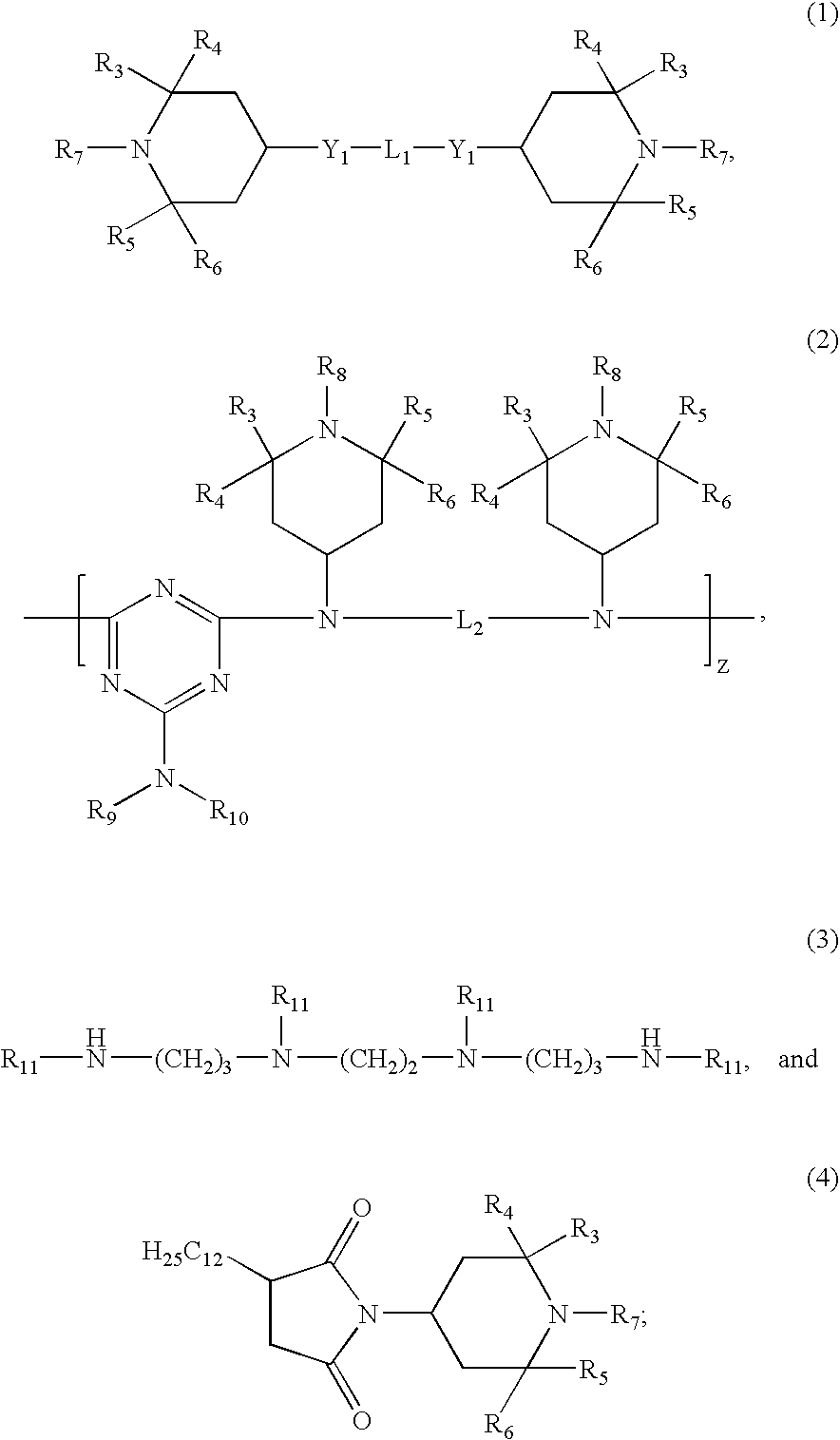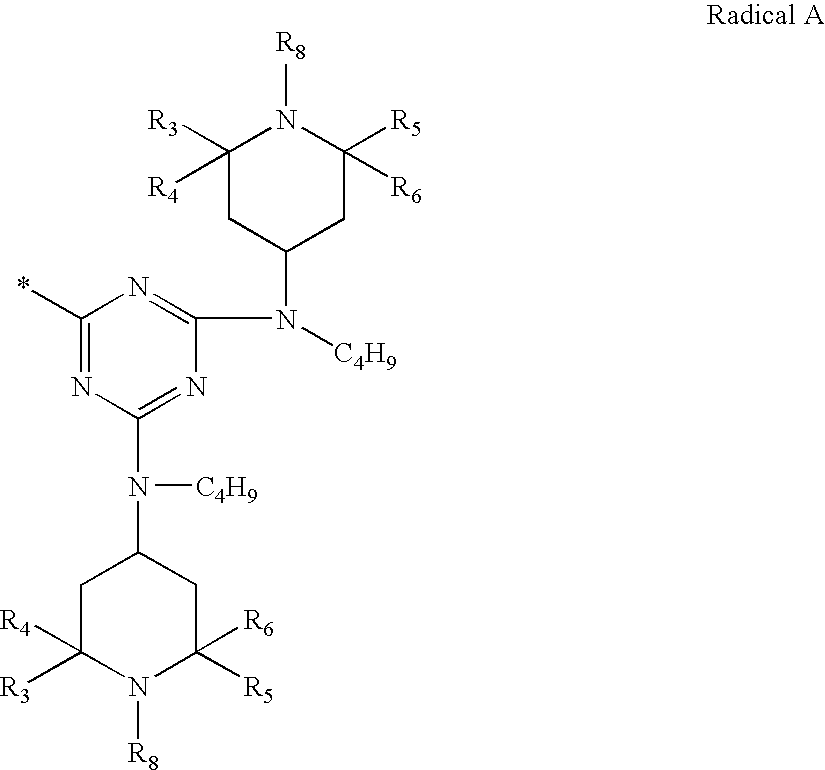Certain polyester compositions which comprise cyclohexanedimethanol, moderate cyclobutanediol, cyclohexanedimethanol, and high trans cyclohexanedicarboxylic acid
a technology of polyester composition and cyclohexanedimethanol, which is applied in the field of polyester compositions, can solve the problems of difficult to form amorphous articles, discoloration and haze, etc., and achieves less reactive, great chemical resistance, and long reaction time
- Summary
- Abstract
- Description
- Claims
- Application Information
AI Technical Summary
Benefits of technology
Problems solved by technology
Method used
Image
Examples
example 1
[0514]This example illustrates the laboratory-scale preparation of a copolyester of CHDA with TMCD and CHDM where the mol % TMCD in the final polymer was about 68% and the mol % of CHDM in the final polymer was about 32%.
[0515]DMCD (about 98 mole % trans, 80.0 g, 0.40 mol), TMCD (46.4 g, 0.31 mol), CHDM (17.3 g, 0.12 mol) and butyltin tris(2-ethylhexanoate) (1.84 mL of an approximately 0.22 M solution in butanol) were charged to a 500 mL single-neck round flask. The flask was fitted with a mechanical stirrer and distillation head and was purged with nitrogen. The flask was immersed in pre-heated Belmont metal bath (240° C.) and the reaction mixture was stirred for 183 min at atmospheric pressure during which time some of the methanol distilled off. The pressure was reduced to 100 torr while the bath temperature was raised to 255° C. over 5 min. The pressure was further reduced to 5 torr over another 5 min, and again reduced to 0.2 torr over another 5 min. The reaction mixture was st...
example 2
[0516]This example illustrates the pilot-scale batch preparation of a copolyester of CHDA with TMCD and CHDM where the mol % TMCD in the final polymer was about 68% and the mol % of CHDM in the final polymer was about 32%.
[0517]Under a nitrogen gas purge, DMCD (about 98 mole % trans, 21.43 lb), TMCD (12.42 lb), CHDM (4.63 lb) and butyltin tris(2-ethylhexanoate) (27.8 g) were charged to a 18-gallon stainless steel pressure vessel which was fitted with a condensing column, a vacuum system, and a HELICONE-type agitator. The contents of the reactor were heated under a nitrogen atmosphere. When the internal temperature reached 50° C., the agitator was set to 25 RPM and the reaction mixture temperature was increased to 150° C. at which time the vessel was pressurized to 25 psig with nitrogen. The reaction mixture was heated to 240° C. and held for 3 hours at 240° C. and 25 psig. The pressure was then decreased to 0 psig at a rate of 3 psig / min. The pressure was further reduced to 100 torr...
example 3
[0518]This example illustrates the pilot-scale batch preparation of a copolyester of CHDA with TMCD and CHDM where the mol % TMCD in the final polymer was about 28% and the mol % of CHDM in the final polymer was about 72%.
[0519]Under a nitrogen gas purge, DMCD (about 98 mole % trans, 21.43 lb), TMCD (5.32 lb), CHDM (10.8 lb) and butyltin tris(2-ethylhexanoate) (27.8 g) were charged to a 18-gallon stainless steel pressure vessel which was fitted with a condensing column, a vacuum system, and a HELICONE-type agitator. The contents of the reactor were heated under a nitrogen atmosphere. When the internal temperature reached 50° C., the agitator was set to 25 RPM and the reaction mixture temperature was increased to 150° C. at which time the vessel was pressurized to 25 psig with nitrogen. The reaction mixture was heated to 240° C. and held for 3 hours at 240° C. and 25 psig. The pressure was then decreased to 0 psig at a rate of 3 psig / min. The pressure was further reduced to full vacu...
PUM
| Property | Measurement | Unit |
|---|---|---|
| concentration | aaaaa | aaaaa |
| Tg | aaaaa | aaaaa |
| Tg | aaaaa | aaaaa |
Abstract
Description
Claims
Application Information
 Login to View More
Login to View More - R&D
- Intellectual Property
- Life Sciences
- Materials
- Tech Scout
- Unparalleled Data Quality
- Higher Quality Content
- 60% Fewer Hallucinations
Browse by: Latest US Patents, China's latest patents, Technical Efficacy Thesaurus, Application Domain, Technology Topic, Popular Technical Reports.
© 2025 PatSnap. All rights reserved.Legal|Privacy policy|Modern Slavery Act Transparency Statement|Sitemap|About US| Contact US: help@patsnap.com



